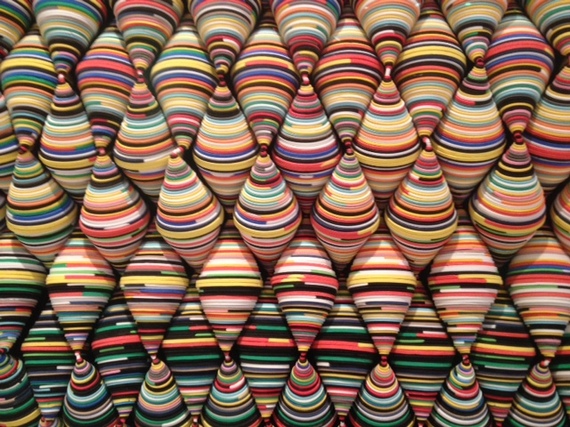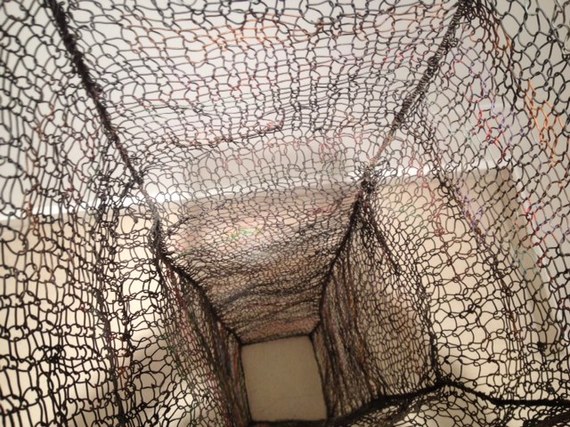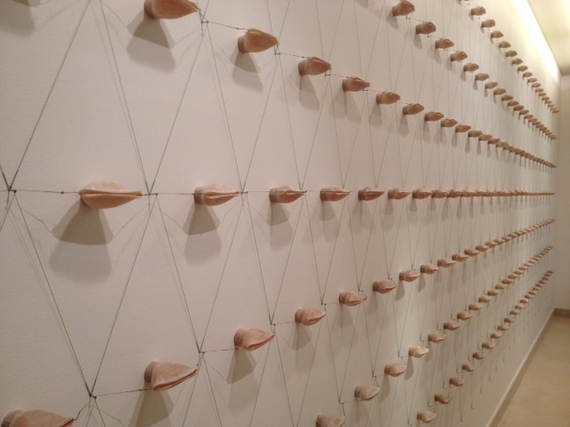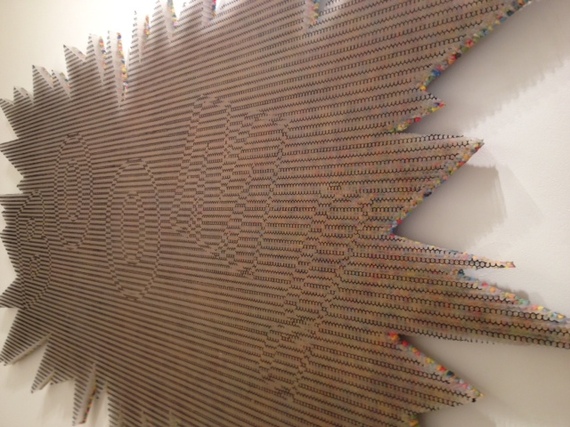The sun was up. A weekday. Seemed the perfect moment to cycle over to see the new blockbuster exhibit of Diego Velasquez, the 17th century Spanish master whose works are scarcely known in France. Alas the line on this second day of the exhibit snaked up and down, in and out for what would have taken at least two hours go get inside--even with a press card. Dejected, we pedaled back toward home beneath the budding chestnuts along Blvd. St. Germain and just happened to glimpse a sign for Latin America House where a much more recent and still more discombobulating Hispanic artist, Carmen Perrin, has a breath-stealing, memory-imploding exhibit of her visual terpsichory.
Bolivian by birth, Swiss by education, introspectively silent by character, Perrin zooms in and out of private and collective memory, her creations like a stack of exploding dreams that skate along from the reassuring to the terrifying.
The objects are simple: layered paper cups painted with tiny images of childhood cartoons, gangster films, the catastrophes of the daily news. Many are also drawn from the foggy zones of high culture turned into pop toys. Those collapsable cups might also be an engine block. But they are each and all multi-zoned visual games and illusions. The intricacy with which paper cups are joined together and reversed or a children's table converted into metallic crochet, reinforce the architectures of a very personal dreamland, not unlike the shifting-sliding world of Latin magical realism that taught the depleted Cartesians to suspect the surfaces of conventional reason.
Since her childhood in La Paz, Perrin says, she has been drawn at once to the surfaces of objects--cups, tables, dried petroleum film, sparkling objects in trash heaps from which older stories emerge. From them she draws us relentlessly into one set of optical illusions after another.
A white, perforated, possibly iron, table and four chairs called Las Chicas recalls the utility and the fragility of ordinary objects, a memory of the Spanish phrase mothers would use to call the kids, las chicas--in her case four sisters--to lunch. The form is there as it might be of any table in the trash, but the memory of what was served with its colors, flavors and textures has fallen through the holes of memory.
A rectangular box composed of variously colored wires suggests that now mostly abandoned space where Clark Kent turned himself into Superman: the phone booth, here twisted and tortured and constructed of actual tiny burnt telephone wires, the wires that kids discovered when they ripped apart those old, heavy black handset phones that were once afforded their own small table in proper houses.
A wall of hardened rubber fish mouths, each punctured by a hook, is united by geometric black fishing lines.
On the opposite wall an explosion of sparkling jagged colors captures a visitor's eyes and as she moves, the colors keep exploding, unwilling to settle down until she arrives at the extremities, left or right, where it all turns into an undulating surface of grays and browns.
Similarly, a thoroughly seductive room of tiny painted rods steals the stability of vision: but don't rest too long inside or you might undergo neuro breakdown.
The message throughout is simple, borrowed, Perrin says, from both the constructivist and the Art Povera movements: you cannot escape the presence of provocative, enticing, distressing art, wherever you are if you are willing to question the illusions of life's daily surfaces.
all photos by Frank Browning








